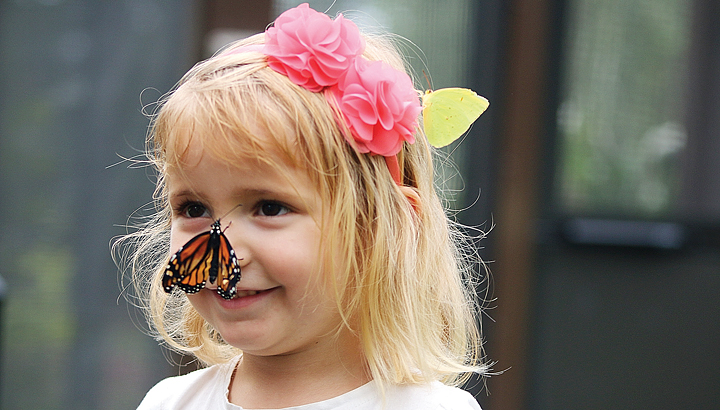A butterfly’s first flight can be exhausting.
After all, the former caterpillar just emerged from its chrysalis. Its newly formed wings are taking its first ever flaps. It must be quite an ordeal. What better place to catch a break than the nose of a young girl.
This is a common scene during a butterfly release at Airlie Gardens.
The Butterfly House at Airlie Gardens completed a summer-long schedule of releases last Saturday. In the summer, butterflies were released on Tuesday afternoons, and once school started in September the gardens held the final three releases on Saturday mornings.
The 2,700-square-foot Butterfly House is located in the Tranquility Garden area of Airlie Gardens. The butterflies and moths of the Butterfly House have all they need in the screened-in structure, which also provides visitors an opportunity to see these colorful flying creatures up close.
To provide the best possible habitat, garden caretakers plant a variety of native plants that caterpillars like. Several species of caterpillar are very particular about the plants they eat. For instance, monarch caterpillars only eat milkweed, said Jennifer O’Keefe, Airlie Gardens environmental education coordinator.
“If you are a monarch and you have 100 leaves to choose from, if it’s not milkweed you won’t eat it,” she said. “We also have some passionflower vine. We had several adults laying eggs on the passionflower vine, which was cool. As larvae, they need this plant. If we don’t have larval plants, then we won’t have the adult butterflies flying around.”
Many of the visitors to the butterfly releases are there to learn about what types of plants and food sources their home gardens need to attract butterflies, O’Keefe said.
Several species of butterflies are released in the house, including monarchs, buckeyes and Gulf fritillaries. Giant swallowtails and red admirals are also common. The house also releases luna moths, which are more versatile in their diet and are known to feast on several types of leaves, like sweetgum, persimmons and birch.
The enclosed house and controlled atmosphere at Airlie Gardens helps the insects beat the odds. In the wild, butterflies don’t fare as well.
“For every 100 eggs that the mother butterfly lays, usually only up to three of those make it to be an adult,” O’Keefe said. “That is in part because of diseases. They actually get several different diseases. But they are also great at turning plants into protein for other animals. Birds eat caterpillars, lizards, frogs, all kinds of things eat caterpillars and adult butterflies. They are an important part of the food chain.”
To stock the house with the insects, Airlie Gardens orders the specimens from suppliers, which are generally delivered in their pupal stage, usually while they are in the chrysalis cocoon that will eventually hatch the winged insect.
The butterfly chrysalises are housed in an emergence chamber, a glass housing that lets the newly hatched butterflies crawl from their cocoons while giving onlookers a great vantage point to view the different colors and patterns on their wings.
“The Gulf fritillary is popular because of the silver underside of its wing,” O’Keefe said. “They’re fun to look at up close and see their patterns,”
The purchased pupal stage specimens are not the only source of butterflies in the garden, as the animals will reproduce on their own. This is evident in the eggs that garden attendants find on the assortment of leaves available in the Butterfly House.
Sometimes, staff at the gardens won’t recognize the kinds of eggs laid on the plants.
“We call those question mark eggs,” O’Keefe said.
Once a caterpillar becomes a butterfly, it will broaden its diet and try new things, especially different nectars. Besides the leafy plants that caterpillars feed on, the Butterfly House also grows several flowering plants for the butterflies to draw nectar.
“Caterpillars only eat certain kinds of leaves and can be super picky,” O’Keefe said. “But once they’re butterflies, they’ll open up and get their minerals from nectar, dung and other places.”
The butterflies also like some of the special treats that the Butterfly House staff offer them.
“Fruit punch Gatorade is a pretty popular favorite among the butterflies,” O’Keefe said. “Even those that don’t like nectar will like the Gatorade.”
O’Keefe added that apple slices are another favorite for butterflies.
While there aren’t any more releases scheduled this year, visitors to the Butterfly House still have a few days left to encounter the various breeds that are housed there. The Butterfly House will close Oct. 15, opening again April 15, 2016.





Two years ago, my wife, Ann, and I started a foundation in Minneapolis, to try to save the Monarch Butterfly. The foundation is SaveOurMonarchs Foundation, devoted to saving Monarchs by planting Milkweed seeds.
So now SaveOurMonarchs.org offers free milkweed seeds to anyone. You can just send your request for seeds to SaveOurMonarchs.org and click on ‘Get ‘Seeds’.
Ward Johnson